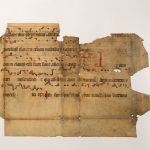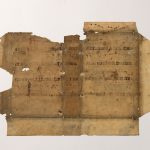On the fragment chants of the Vespers, Matins and Lauds of John and Paul’s office have survived. On the recto, which supposedly preserves the smaller part of the original folio, much of the Magnificat antiphon Isti sunt duae olivae is legible. Then the Matins’ rubric follows: the incipits of the invitatory and the antiphon refer to Commune Sanctorum chants. The responsory Isti sunt duo viri is notated in full with its usual verse Isti sunt duae olivae. Presumably these are the chants of the third Nocturn, although the source does not provide guidance regarding whether the chants of the first and second Nocturn should be taken from the Commune. The antiphons 2–5 of the Lauds are written on the verso. Their order reveals a lot about the codex’s provenance: exactly the same order can solely be found in Esztergom. Not only the Central-European uses differ – although only in small details – from this order, but also the wellknown local traditions subordinated to the Hungarian main church, eg. Kalocsa-Bács and Transylvania. It is important to note that the ant. Ioannes et Paulus congnoscentes in other uses cannot be found in second place of the Lauds series (apart from the Istanbul antiphoner, the only stray data among the 84 concordances of the Cantus-index comes from a source of Silos, GB-Lbl MS30850).
The placement of this chant could in itself confirm the Esztergom provenance, but what leaves no doubt about this origin is the notation: a traditional, late Esztergom form. This handwriting is punctiliously executed with strictly designed neume forms. The notation gives an archaic impression at first sight, but this is deceptive: in terms of the selection of the neume forms, i.e. the essence of the music script, the scribe chose the path of modernisation. The penstrokes thickened, the archaic conjunct Esztergom neumes disintegrated (see, for example, the pes stepping a second, the torculus and the porrectus). The double-note beginning of the climacus and its conjunct form are also archaic traits, nevertheless the horizontal lines of puncta in the climacus’ primary form follow the Gothic manner of slanting the neume to the right. The scandicus has also a new, separated shape, which forms the middle note of the sign with a separate stroke. Despite the many innovations, the disintegrated neume structures and the new direction of the music script, the notation is sophisticated and elegant, as it can takes place amongst the most beautiful Esztergom notations.
Gabriella Gilányi



